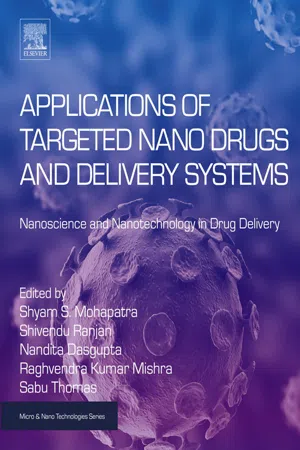
Applications of Targeted Nano Drugs and Delivery Systems
Nanoscience and Nanotechnology in Drug Delivery
- 682 pages
- English
- ePUB (mobile friendly)
- Available on iOS & Android
Applications of Targeted Nano Drugs and Delivery Systems
Nanoscience and Nanotechnology in Drug Delivery
About This Book
Applications of Targeted Nano-Drugs and Delivery Systems: Nanoscience and Nanotechnology in Drug Delivery explores the applications of Nano-drugs and their delivery systems, investigating the role they can play in key body systems and major diseases. The book explores how nanotechnology can be deployed in developing new drug delivery systems and how they enable pharmaceutical companies to reformulate existing drugs on the market, thereby extending the lifetime of products and enhancing performance by increasing effectiveness, safety and patient adherence, and ultimately reducing healthcare cost. Reflecting the interdisciplinary nature of the subject matter, this book includes contributions by experts from different fields.
Readers will find a reference and practical source of guidance for researchers, students and scientists working in the fields of nanotechnology, materials science, and technology and biomedical science.
- Enables readers from different fields to access recent research and protocols across traditional boundaries
- Focuses on protocols and techniques, as well as the knowledge base of the field, thus enabling those in R&D to learn about, and successfully deploy, cutting-edge techniques
- Explores the applications of Nano-drugs and their delivery systems, investigating the role they can play in key body systems and major disease types
Frequently asked questions
Information
Nanotherapeutics and Nanobiotechnology
Abstract
Keywords
1. Introduction
2. Advantages
- 1. Nanoparticles that are used in biotherapeutics can stimulate molecular imaging as well as be used for brain tissue engineering and drug delivery through the blood–brain barrier (BBB) [4].
- 2. By taking advantage of diseased tissue as it is has a path of physiological impact, one can engineer targeted nanodelivery.
- 3. Nanoformulations in biotechnology can evade the BBB to improve CNS-directed neuroprotection or regeneration [4].
- 4. Nanoparticles can easily adapt by changing their size and shape to assist drug uptake [4,5].
- 5. Biotherapeutics are very target specific, potent, and have fewer side-effects compared to conventional molecules and devices so they are widely preferred in the biotechnology field [6].
-

Figure 1.1 Manufacturing of biologics. - 6. Nanoparticulate carriers that are used in biotechnology are found to be more active therapeutically in treating brain tumors [7].
- 7. Nanoparticulate drug delivery systems are found to be successful in the pharmacokinetic strategies of drug molecules such as biodistribution, bioavailability, and drug release features in a controlled and effective manner with site-specific drug delivery targeting to tissue or cell with drop in toxic manifestation [7].
- 8. DNA and RNA molecules, coined aptamers, which are used as a carrier in the biotechnology field, provide high affinity and binding [8].
- 9. Nanocarrier-based oral drug delivery in biotechnology, which includes certain proteins and enzymes, improves the oral absorption of drugs, escalation of aqueous solubility and dissolution rate, enriches lymphatic transport, and is devoid of enzymatic degradation [9].
- 10. Nanomaterials with high thermal, mechanical, and optical properties are favorable materials for development of biosensors that are used in various types of cancers [8].
- 11. Protein-based nanoparticles are used for encapsulation of active molecules because of their nontoxic and biodegradable nature so they are frequently used in biotherapeutics [9].
- 12. Targeted delivery in which nanoparticles are incorporated with drug with conjugation of tumor-specific cell surface markers, like tumor-specific antibodies or ligands, enhance the potency of anticancer drugs and produce fewer side effects [10].
- 13. Sizes of nanoparticles are quite analogous to biological molecules and their structures so they are widely used in in vivo and in vitro biomedical research [11].
- 14. Drug targeting is easily accomplished by using nanoparticles as carriers in biotechnology because of different pathophysiological structures of disease tissue [11].
- 15. Drug concentration at target size is higher in case of nano drug delivery as compared to conventional delivery.
- 16. Nano drug delivery enhances drug efficacy and reduces drug toxicity.
3. Fabrication Challenges
Table of contents
- Cover image
- Title page
- Table of Contents
- Copyright
- List of Contributors
- Foreword
- Chapter 1. Nanotherapeutics and Nanobiotechnology
- Chapter 2. Application and Perspective of pH-Responsive Nano Drug Delivery Systems
- Chapter 3. Mechanism for Development of Nanobased Drug Delivery System
- Chapter 4. Nanobased Nano Drug Delivery: A Comprehensive Review
- Chapter 5. Recent Advances in Development of Nano Drug Delivery
- Chapter 6. Thermoresponsive Drug Delivery Systems, Characterization and Application
- Chapter 7. Graphene and Graphene-Based Nanomaterials Are Suitable Vehicles for Drug Delivery
- Chapter 8. Combination Strategies for Targeted Delivery of Nanoparticles for Cancer Therapy
- Chapter 9. Nanotechnology Toward Treating Cancer: A Comprehensive Review
- Chapter 10. Nanoparticles as Delivery Systems in Cancer Therapy: Focus on Gold Nanoparticles and Drugs
- Chapter 11. Trends in Nanotechnology for Practical Applications
- Chapter 12. Antiviral and Antimicrobial (Antibacterial) Potentiality of Nano Drugs
- Chapter 13. Antiviral and Antimicrobial Potentiality of Nano Drugs
- Chapter 14. Nanotechnology in Targeted Drug Delivery and Therapeutics
- Chapter 15. Engineering Nanomaterials for Smart Drug Release: Recent Advances and Challenges
- Chapter 16. Nano Drugs for Curing Malaria: The Plausibility
- Chapter 17. Nanoparticles Mediated Gene Knockout Through miRNA Replacement: Recent Progress and Challenges
- Chapter 18. Transdermal and Intravenous Nano Drug Delivery Systems: Present and Future
- Chapter 19. Nanobased Intravenous and Transdermal Drug Delivery Systems
- Chapter 20. Electrospun Nanofibers for Drug Delivery in Regenerative Medicine
- Index